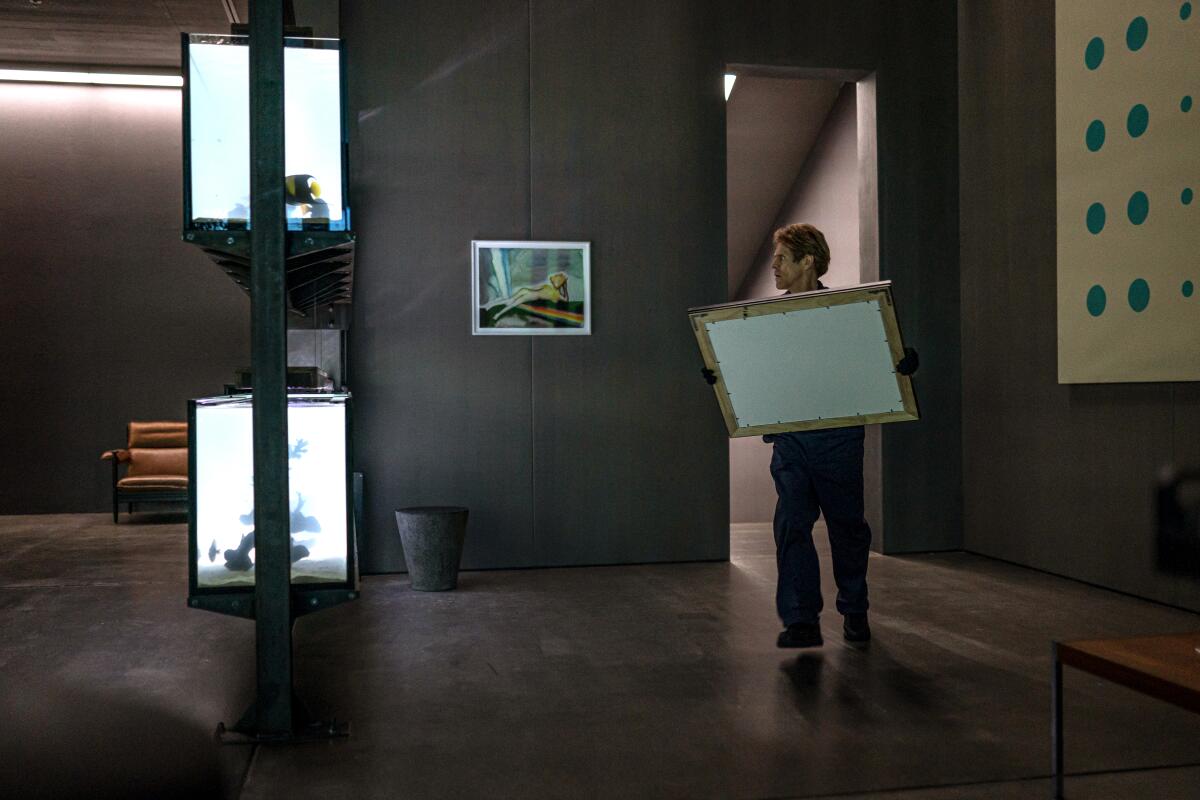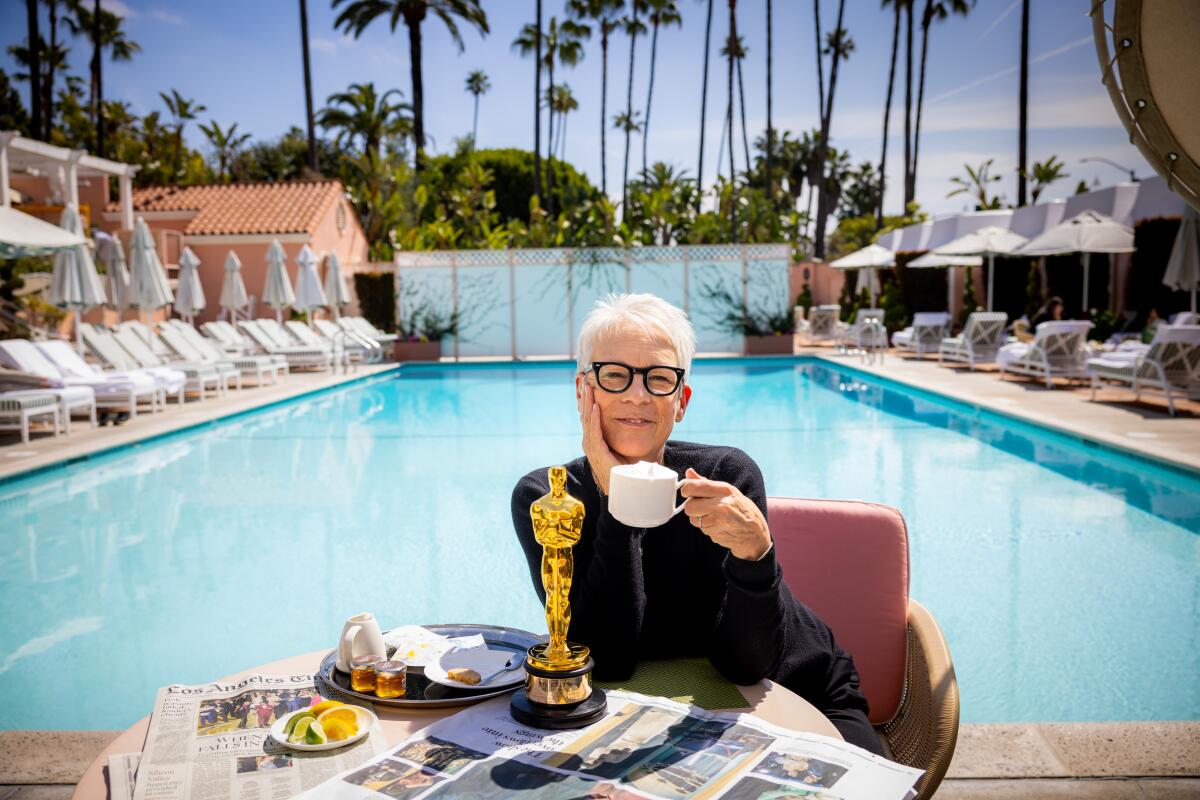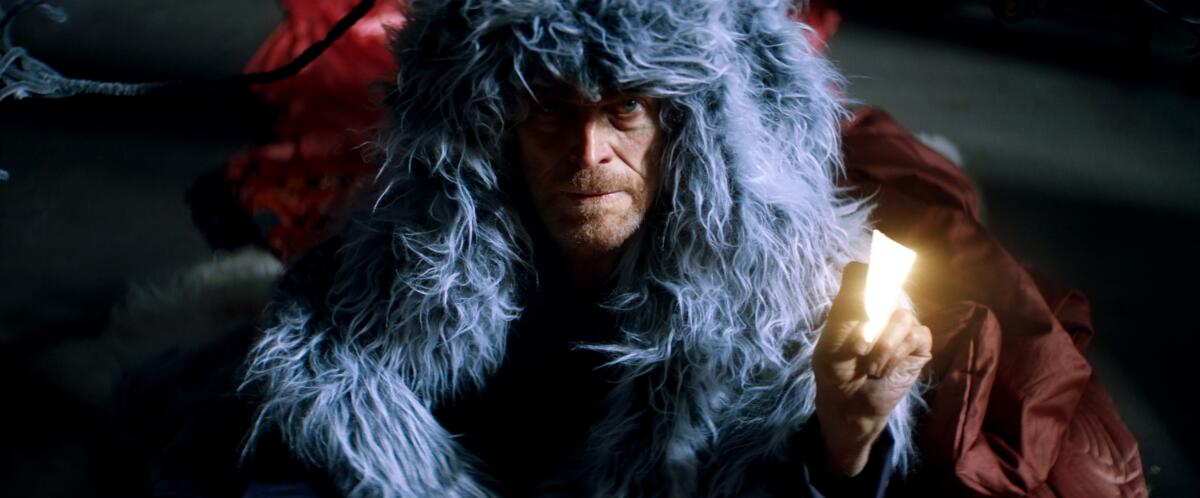Willem Dafoe gets ‘Inside’ an existential thriller

- Share via
Hello! I’m Mark Olsen. Welcome to another edition of your regular field guide to a world of Only Good Movies.
Only good movies
Get the Indie Focus newsletter, Mark Olsen's weekly guide to the world of cinema.
You may occasionally receive promotional content from the Los Angeles Times.
If you’re reading this newsletter, you are probably aware that the Oscars happened last weekend, with “Everything Everywhere All at Once” taking seven statuettes, including best picture, director, original screenplay, actress, supporting actress, supporting actor and editing. But our coverage doesn’t end when the show is over, as there is still plenty to mull over, dissect and discuss.
Justin Chang wrote about “Everything Everywhere” and how — as oddball as the movie might seem — it is a very traditional tale of family, one that he has turned over in his mind multiple times and in many different ways. (A multiverse of opinions, as it were.)
As he wrote, “How to reckon, then, with the fact that ‘Everything Everywhere All at Once,’ with its phenomenal box office success and seven Oscar wins Sunday night, now stands as the most culturally and commercially significant Asian American movie ever made? It’s undeniably a watershed moment, and after roughly a century’s worth of Hollywood indifference to Asian characters, actors, stories and storytellers — plus the past few years’ heightened anti-Asian violence and rhetoric — it’s not one to be taken lightly.”
With the acting prizes going to Brendan Fraser, Michelle Yeoh, Jamie Lee Cutis and Ke Huy Quan, I examined whether this was the “Year of the Comeback” at the Oscars.
“Dreams are something you have to believe in. I almost gave up on mine. To all of you out there, please keep your dreams alive,” Quan said in his deeply emotional speech. He concluded by saying, “Thank you so much for welcoming me back.”
As much as there was to celebrate that night, there was still room to do better. While “Naatu Naatu” from “RRR” became the first original song winner for a film from India, as Jen Yamato and Helen Li reported, the performance of the song on the telecast did not feature any performers from South Asia.
Michael Ordoña, James Reed, Amy Kaufman and Jen Yamato hit the afterparty circuit, from the academy’s own Governors Ball to events thrown by Elton John and Vanity Fair.
After all his work at the Governors Ball, photographer Jay L. Clendenin also got fantastic shots of Jamie Lee Curtis at the Beverly Hills Hotel the morning after.

Enjoying this newsletter? Consider subscribing to the Los Angeles Times
Your support helps us deliver the news that matters most. Become a subscriber.
‘Inside’
Directed by Vasilis Katsoupis from a screenplay by Ben Hopkins, “Inside” is something of an existential thriller about an art heist gone wrong. When Nemo (the eminently compelling Willem Dafoe) finds himself trapped inside a luxury apartment while trying to steal the multimillion-dollar art kept there, he struggles to survive and figure out a way to escape. The movie is in theaters now.
For Tribune News Service, Katie Walsh wrote, “Katsoupis calls into question the overly inflated value of art while reminding us that expression is inherently human and elemental. It sits closer to the top on our hierarchy of needs than we might assume. Katsoupis poses these probing and provocative questions about humanity but doesn’t offer any clear answers or messages. Rather, he lets his muse, Dafoe, simply inhabit this harrowing journey with his strange magnetism and sense of timelessness, in a performance that is simultaneously primitive and transcendent. Nemo becomes a figure straight out of Greek mythology, reckoning with the forces of creation and destruction, but it’s unclear whether he’s Sisyphus, Prometheus or perhaps even Icarus.”
Emily Zemler spoke to Katsoupis and art curator Leonardo Bigazzi about creating the art collection seen throughout “Inside,” which involved both gathering preexisting works and commissioning new ones specifically for the film. As Katsoupis said, “I had an idea for the collection in my mind, but I needed an expert to make it legit. We’ve seen too many films that have to do with art and most of the time the art is fake or look-alikes. I really wanted in my film for everything to be very, very correct.”
For the New York Times, Amy Nicholson wrote, “Katsoupis and the screenwriter Ben Hopkins aren’t concerned with making a credible heist caper. Katsoupis is more of a snotty provocateur with the elegance to posture as deep. He sneers at the rich, stocking the stony apartment with futile luxuries that give it the feel of a pharaoh’s tomb. … When boredom sets in, we’re offered the silence to contemplate our own definition of art as Nemo the criminal evolves into Nemo the creator. His towering escape contraptions are tools. His haunting wall doodles are therapy. They’re both awarded as much reverence as everything with a price tag.”
For Rolling Stone, David Fear wrote, “There are suggestions that some, or maybe most of what we’re seeing may not be real, especially when Nemo’s hallucinations begin to outweigh the more realistic scenes of his isolation. Yet ‘Inside’s’ attempts at playing existential head games don’t quite track either, and you can sense that courting such pretentiousness is not a winning hand for this film to play. … What is clear is that great actors can do a lot to sell an ingenious idea that ends up being both its distinguishing factor and its own worst enemy. Yet even an Oscar-nominated GOAT can’t escape something that seems so perfectly put together on the outside and is so flawed, easily trashed, and barely held together on the inside.”
For IndieWire, Kate Erbland wrote, “For a film so fixated on art — expensive art, crazy art, serious art — ‘Inside’ abandons its most compelling queries too quickly. What good is any of this art in the face of real necessity? By the time Nemo uses a priceless statue to pry open a door, his conversion seems obvious; once he takes another and folds it up into a tent, it’s complete. It’s also far too blunt, just like ‘Inside.’ Real art asks questions, it doesn’t answer them in the plainest possible terms.”

‘Moving On’
Written and directed by Paul Weitz, “Moving On” is a mix of Neil Simon/Mike Nichols sophisticated farce with a Robert Altman-like rabble-rousing sensibility. At the funeral of an old college friend, Claire (Jane Fonda) tells Evelyn (Lily Tomlin) she intends to murder the deceased woman’s husband, Howard (Malcolm McDowell), as revenge for a traumatic event in the past that led to the end of Claire’s marriage to Ralph (Richard Roundtree). The film is in theaters now.
For The Times, Gary Goldstein called the film “an amusing and bittersweet little tale of love, friendship and, yes, retribution.” He added, “Fonda and Tomlin, who’ve become a kind of latter-day female version of Matthau and Lemmon, not only enjoyably display their lived-in chemistry but bring expert nuance and pathos to their characters’ many emotional turns — big and small. If that’s no great shock, given the length, breadth and caliber of their careers, it’s still stirring and impressive to behold.”
For the New York Times, A.O. Scott wrote, It becomes clear fairly early on that ‘Moving On’ is operating in strange and risky genre territory. If the phrase ‘rape-revenge comedy’ sounds like an oxymoron, this movie won’t convince you otherwise. … Something else is missing here — a farcical energy or satirical audacity that might shock the premise to unsettling life, or else a deeper, darker core of feeling. ‘Moving On’ takes refuge in pleasantness, and in the easy charm of its stars. Who are, as I’ve said, consistently enjoyable to watch. Which might be the problem.”
For the AP, Lindsey Bahr wrote, “This is one of those rare films that balances a darkly comedic conceit with authentic, emotional resonance, allowing Fonda, Tomlin and co-stars Malcolm McDowell and Richard Roundtree to actually act rather than be demeaned by cheap caricatures of senior citizens. … Hopefully performances like these will remind screenwriters, directors and those who make the decision about what gets made to give our living legends good roles while we still have them. The actors are still game, and hopefully audiences are too.”

‘Full River Red’
Directed and co-written by Zhang Yimou, “Full River Red” has become the biggest box office hit of his long career in the filmmaker’s native China, currently said to be the country’s sixth-highest-grossing film ever. Based on a well-known historical poem, with a cast that includes Jackson Yee, Shen Teng and Lei Jiayin, the story, ostensibly an epic-scaled murder mystery, mixes comedy and political intrigue. The film is in theaters now.
For The Times, Justin Chang wrote, “What lies at the heart of the labyrinth is best not divulged too explicitly here, though it may account for why the movie has become a box office smash (it’s grossed more than $600 million at home) and the biggest commercial success of Zhang’s prolific, alternately charmed and embattled career. ‘Full River Red’ is the title of a famous poem — a lament and a war cry (“There we shall feast on barbarian flesh”), believed to have been written by the Song Dynasty general Yue Fei — that nearly everyone in China is said to know by heart. That lends more than a touch of jingoism to this otherwise amusing, mechanistic parlor trick, which builds to a surge of emotion that might make your heart sink or soar.”
For the New York Times, Brandon Yu wrote, “Despite a prolific filmography of grandiose art house fare that has often wrestled with the vast span of Chinese history, the filmmaker has suffused a dynastic war fable with elements of a slapstick whodunit. Yet the light charm, mostly offered by Shen as the oafish sidekick, serves as a saving grace amid the shadowy political games. … The lighthearted tone poking through keeps it afloat, and suspends the viewer in mostly carefree entertainment for its two-and-a-half-hour running time.”

Only good movies
Get the Indie Focus newsletter, Mark Olsen's weekly guide to the world of cinema.
You may occasionally receive promotional content from the Los Angeles Times.




